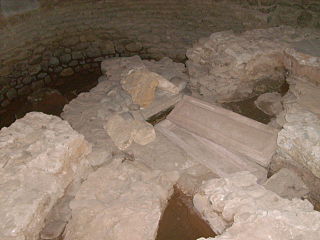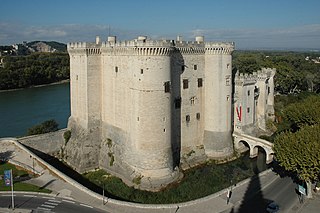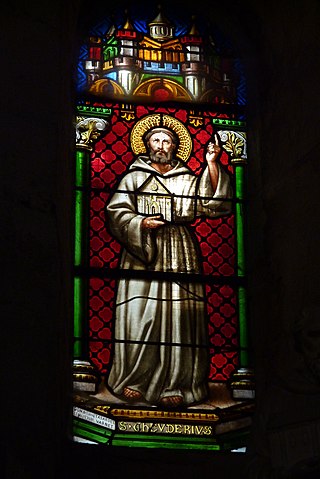
Vaison-la-Romaine is a town in the Vaucluse department in the Provence-Alpes-Côte d'Azur region in southeastern France.

The Diocese of Fréjus–Toulon is a Latin diocese of the Catholic Church in southeastern France on the Mediterranean coast. The present diocese comprises the territory of the ancient Diocese of Fréjus as well as that of the ancient Diocese of Toulon. In 1957 it was renamed as the Diocese of Fréjus–Toulon.

The Archdiocese of Aix-en-Provence and Arles is a Latin Church ecclesiastical territory or archdiocese of the Catholic Church in France. The archepiscopal see is located in the city of Aix-en-Provence. The diocese comprises the department of Bouches-du-Rhône, in the Region of Provence-Alpes-Côte d'Azur. It is currently a suffragan of the Archdiocese of Marseilles and consequently the archbishop no longer wears the pallium.

Caprasius, sometimes Caprasius of Lérins, was a hermit who lived in Lérins, Provence.

The Diocese of Vaison was a Roman Catholic diocese in France, suppressed in 1801, with its territory transferred to the Diocese of Avignon. It had been one of nine dioceses in the ecclesiastical province presided over by the archbishop of Arles, but a later reorganization placed Vasio, i.e. today's Vaison-la-Romaine, under the archbishop of Avignon. Jurisdiction inside the diocese was shared between the bishop and the Comte de Provence, higher justice and the castle belonging to the Comte, and civil justice and all other rights belonging to the bishop. The cathedral was served by a chapter which had four dignities: the provost (praepositus), the archdeacon, the sacristan, and the precentor. There were also six canons, each of whom had a prebend attached to his office.

Saint Lucian of Beauvais is a Christian martyr of the Catholic Church, called the "Apostle of Beauvais." He was killed in the 3rd century during the Diocletian persecution, although later traditions make him a martyr of the 1st century instead. This was because the church of Beauvais attempted to claim apostolic origins for itself. Odo, bishop of Beauvais during the 9th century, was the first writer to designate Lucien as the first bishop of Beauvais.
Leontius was a bishop of Fréjus, in Provence. He was probably born at Nîmes, towards the end of the fourth century; he died in his episcopal town in 488, according to some authorities, though others say 443 or 448. He is venerated as a saint in the Catholic and Eastern Orthodox churches; his feast day is 1 December.

The former French Roman Catholic Diocese of Saint-Paul-Trois-Châteaux, sometimes, just like the town, also known as the Diocese of Saint-Paul-en-Tricastin, existed from the sixth century to the French Revolution.

The Diocese of Le Mans is a Latin Church diocese of the Catholic Church in France. The diocese is now a suffragan of the Archdiocese of Rennes, Dol, and Saint-Malo, but had previously been suffragan to Bourges, Paris, Sens, and Tours.

Fréjus Cathedral is a Roman Catholic church located in the town of Fréjus in the Var department of Provence, southeast France, and dedicated to Saint Leontius of Fréjus.

The Diocese of Saint-Dié (Latin: Dioecesis Sancti Deodatiis; French: Diocèse de Saint-Dié is a Latin Church ecclesiastical territory or diocese of the Catholic Church in France. The diocese has the same boundaries as the département of the Vosges. The bishop's cathedra is Saint-Dié Cathedral in the town now named Saint-Dié-des-Vosges, but since 1944 has lived in Épinal, capital of the département. The Diocese of Saint–Dié is a suffragan diocese in the ecclesiastical province of the metropolitan Archdiocese of Besançon.

John of the Grating was a Cistercian Bishop of Aleth. He moved his episcopal see to Saint-Malo to protect it from pirates.

The historic French province of Provence, located in the southeast corner of France between the Alps, the Mediterranean, the Rhône river and the upper reaches of the Durance river, was inhabited by Ligures beginning in Neolithic times; by the Celtic since about 900 BC, and by Greek colonists since about 600 BC. It was conquered by Rome at the end of the 2nd century BC. From 879 until 1486, it was a semi-independent state ruled by the Counts of Provence. In 1481, the title passed to Louis XI of France. In 1486 Provence was legally incorporated into France. Provence has been a part of France for over 400 years, but the people of Provence, particularly in the interior, have kept a cultural identity that persists to this day.

Pierre de Casa, prior general of Carmelite Order, bishop of Vaison-la-Romaine and Latin Patriarch of Jerusalem

Saint Theuderius was a Christian monk, abbot and hermit. His feast day is 29 October.
Theodosius of Arles, was Archbishop of Arles c. 632–650.
Ithier, was Archbishop of Arles from before March 963 until 981.

Laugier of Nice, known as the Roux, is also known as Laugier of Orange-Mévouillon or Laugier of Vence. He was co-lord of Nice, Gréolières, Cagnes and Vence. He held these titles in part through his wife Odile of Provence and his father-in-law, William I of Provence. Laugier seems to be related to the Mévouillon-Orange lineage. Some historians give him the title of viscount. He was a member of the first house of the counts of Orange-Nice. From 1023 Laugier was a monk of the order of Cluny.

Serenidus of Saulges was a 7th-century Italian Benedictine monk. His feast day is celebrated on May 7, with his brother Serenicus, or locally on August 16.
















